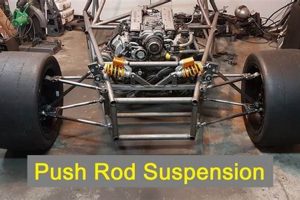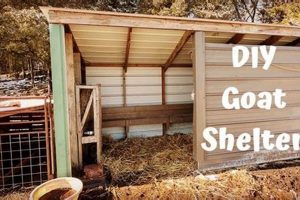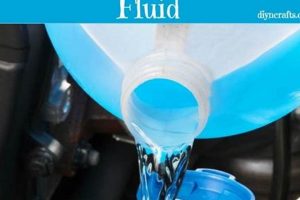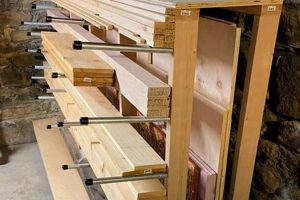A device constructed at home for the purpose of precisely cutting foam materials is often created by hobbyists, artists, and professionals. These typically employ a heated wire or blade to melt through the foam, resulting in cleaner and more accurate cuts than mechanical methods like knives or scissors. Examples include repurposing electrical components to heat a nichrome wire stretched across a frame.
Constructing cutting implements for pliable materials allows for cost savings and customization, specifically where commercial options are either too expensive or do not meet precise project requirements. The practice encourages resourcefulness and adaptability and has its roots in simple engineering principles and the availability of basic electronic components. Its relevance has grown with the increasing use of foams in crafts, model making, and insulation projects.
The following sections will detail the components, construction methods, safety precautions, and diverse applications related to building these specialized tools.
Tips for Effective Foam Material Cutting
This section presents actionable guidelines for achieving optimal results when employing a self-constructed foam material cutting apparatus. Adherence to these principles enhances precision and safety.
Tip 1: Wire Tension Adjustment: Ensure uniform tension across the heated wire element. Insufficient tension results in bowing and imprecise cuts. Excessive tension may lead to wire breakage. Regular inspection and minor adjustments are essential.
Tip 2: Temperature Calibration: Experiment with varying voltage levels to identify the optimal cutting temperature. Excessive heat scorches the foam, while insufficient heat slows the cutting process and creates drag. Testing on scrap material is recommended prior to commencing primary cuts.
Tip 3: Cutting Speed Control: Maintain a slow, consistent cutting speed. Forcing the wire through the foam results in uneven edges and potential warping. Let the heat melt the foam without applying excessive pressure.
Tip 4: Ventilation Considerations: Operate the device in a well-ventilated area to minimize inhalation of fumes released during the melting process. Implementing a fume extraction system is advisable for prolonged use.
Tip 5: Foam Material Selection: Different foam densities and compositions require distinct temperature settings and cutting speeds. Conduct preliminary tests to determine the appropriate parameters for each specific material type. Polyurethane foams react differently to heat compared to polystyrene foams.
Tip 6: Frame Stability: Secure the frame of the tool to a stable surface to prevent movement during operation. Unstable frames compromise the accuracy of cuts and may increase the risk of accidents.
Tip 7: Protective Gear: Always wear appropriate protective gear, including eye protection and gloves, to guard against potential burns or flying debris. Safety glasses shield against potential splattering of molten foam.
Tip 8: Regular Cleaning: After use, remove any accumulated foam residue from the heated wire and surrounding components. Buildup reduces the tool’s efficiency and may pose a fire hazard.
Implementing these tips will contribute to more accurate, cleaner cuts and a safer operational environment. Consistent application of these principles is crucial for realizing the full potential of foam material cutting tools.
The next section will discuss safety guidelines associated with this type of equipment.
1. Wire Heat Control
Wire heat control is a foundational aspect of self-constructed foam material cutting devices. The ability to precisely regulate the temperature of the cutting wire directly influences the quality, efficiency, and safety of the cutting process. Without adequate control, the device is rendered either ineffective or hazardous.
- Voltage Regulation
Voltage regulation dictates the amount of electrical current flowing through the cutting wire. Higher voltage results in increased current and, consequently, higher wire temperature. Conversely, lower voltage reduces temperature. A common method involves using a variable power supply or a potentiometer to adjust the voltage level. The selection of the appropriate voltage is critical for achieving the desired cutting temperature without causing the wire to overheat and break or underheat and fail to melt the foam effectively. For example, cutting low-density polystyrene foam typically requires a lower voltage setting compared to cutting denser polyurethane foam.
- Wire Material Properties
The material composition of the cutting wire significantly affects its heat-generating characteristics. Nichrome wire is commonly utilized due to its high resistance, which efficiently converts electrical energy into heat. Different gauges of nichrome wire exhibit varying resistance levels; thinner wires heat up faster but are more prone to breakage at higher temperatures. The wire’s ability to maintain its structural integrity at elevated temperatures is also a key consideration. Tungsten wire, while having a higher melting point than nichrome, is less commonly used due to its higher cost and increased difficulty in sourcing for small-scale projects.
- Feedback Mechanisms
Sophisticated foam cutting devices incorporate feedback mechanisms to automatically adjust the wire temperature based on real-time conditions. These mechanisms may involve thermocouples to measure the wire temperature and electronic circuits to adjust the voltage accordingly. This ensures consistent cutting performance, especially when dealing with variations in foam density or ambient temperature. A basic example could be a thermistor in contact with the wire connected to a microcontroller that adjusts the output voltage.
- Cooling Considerations
While the primary goal is to heat the wire for cutting, managing the heat buildup in the surrounding components is essential. Excessive heat can damage the power supply, the frame of the cutting device, or pose a burn hazard to the user. Implementing heat sinks or ventilation can help dissipate excess heat. In basic designs, allowing adequate space around the power supply and ensuring sufficient air circulation can be sufficient. In more advanced, enclosed designs, a small fan to circulate air may be necessary.
In summary, effective wire heat control within a foam material cutting apparatus requires careful consideration of voltage regulation, wire material properties, feedback mechanisms, and cooling considerations. These factors interact to determine the device’s performance, safety, and longevity. By optimizing these parameters, operators can achieve precise, clean cuts while minimizing the risk of equipment damage or personal injury. The careful balance of these considerations is integral to the design and operation of any homemade foam cutter.
2. Frame Rigidity
Frame rigidity constitutes a critical design parameter in the construction of self-assembled foam material cutting devices. The frame provides the structural foundation upon which the cutting wire is mounted and tensioned. Insufficient frame rigidity directly compromises the accuracy and consistency of cuts. If the frame flexes or bends under the tension of the wire or during the cutting process, the cutting path deviates from the intended trajectory. For example, a frame constructed from thin plywood may exhibit unacceptable flexing, leading to curved or uneven cuts, particularly when cutting thicker foam sheets. Conversely, a frame fabricated from a material such as aluminum extrusion or reinforced steel provides enhanced stability, maintaining the wire’s alignment and ensuring precise cuts. The dimensions of the frame and the methods used to join its components directly influence its overall stiffness.
The consequences of inadequate frame rigidity extend beyond mere aesthetic imperfections. In applications where dimensional accuracy is paramount, such as model making or architectural prototyping, even minor deviations can render the cut pieces unusable. Furthermore, instability in the frame can induce vibrations, which translate into rough or jagged edges on the cut foam. This necessitates additional post-processing, increasing the time and effort required to achieve the desired results. In industrial applications where these implements are used for tasks such as insulation cutting, maintaining the proper dimensions is paramount. An inflexible frame allows for repeatable accurate cuts.
In summary, frame rigidity serves as a cornerstone for achieving precision and repeatability in self-constructed foam material cutting equipment. A stable and robust frame minimizes deviations in the cutting path, reduces vibrations, and ensures dimensional accuracy. Investing in appropriate frame materials and construction techniques is essential for realizing the full potential of these devices, especially in applications where precision is a critical requirement. Understanding the practical impact of frame construction is crucial in designing and using this type of home-built equipment.
3. Cutting Precision
Cutting precision is a primary consideration in the design and utilization of self-constructed foam material cutting devices. The ability to achieve accurate and repeatable cuts directly influences the utility and applicability of these tools across diverse domains.
- Wire Guidance Systems
Wire guidance systems, encompassing both physical guides and tensioning mechanisms, play a pivotal role in maintaining a consistent cutting path. Physical guides, such as bearings or rollers, constrain the wire’s movement, preventing lateral deviations during the cutting process. Tensioning mechanisms, typically employing springs or adjustable screws, ensure that the wire remains taut and aligned. For instance, in model aircraft construction, precise cuts are essential for creating aerodynamic components; a well-designed guidance system enables the accurate fabrication of wings and control surfaces. Without effective guidance, the wire may wander, resulting in inaccurate dimensions and compromised functionality.
- Temperature Stability
Maintaining a stable wire temperature is crucial for achieving uniform cutting depth and minimizing material distortion. Fluctuations in temperature can cause the wire to melt the foam unevenly, leading to ragged edges and dimensional inaccuracies. Temperature control systems, often incorporating feedback loops and precise voltage regulation, mitigate these fluctuations. For example, in architectural modeling, where scaled representations of buildings must adhere to strict proportions, temperature stability ensures that each cut is consistent and accurate, preventing cumulative errors that could compromise the model’s integrity.
- Cutting Speed Control
Consistent cutting speed is another determinant of precision. Variations in cutting speed can lead to uneven heat distribution and inconsistent melting of the foam. Slow, controlled movements allow the wire to melt through the foam cleanly, while rapid movements may cause the wire to snag or tear the material. In applications such as custom packaging, where foam inserts must precisely fit the contours of the packaged item, consistent cutting speed is essential for creating snug and secure compartments. Maintaining uniform motion ensures that the edges are smooth and the dimensions are accurate, protecting the contents from damage during transit.
- Material Properties
The properties of the foam being cut significantly impact cutting precision. Different foam densities and compositions exhibit varying melting points and thermal conductivities, requiring adjustments to wire temperature and cutting speed. For example, cutting high-density polystyrene foam requires a higher temperature and slower cutting speed compared to cutting low-density polyurethane foam. Understanding these material properties and adjusting the cutting parameters accordingly is essential for achieving optimal results. In crafting applications, a clean precise cut ensures a presentable finished product.
These interrelated aspects collectively determine the degree of cutting precision achievable with self-constructed foam material cutting devices. Optimizing these parameters is essential for realizing the full potential of these tools, particularly in applications where accuracy and consistency are paramount. Without considering these factors, performance and safety are compromised, limiting this tool’s usefulness.
4. Material Compatibility
Material compatibility is a pivotal aspect of using self-assembled foam cutting devices. The diverse range of foam materials necessitates a nuanced understanding of their individual properties and interactions with the heated wire, ensuring efficient operation and preventing damage to either the device or the material being processed.
- Foam Composition and Melting Point
The chemical composition of the foam dictates its melting point and behavior when exposed to heat. Polystyrene foams, for example, tend to melt cleanly at relatively low temperatures, while polyurethane foams may require higher temperatures and can produce more fumes. The correct temperature setting prevents scorching or incomplete cutting. Selecting the wrong parameters results in poor cut quality and potentially hazardous emissions.
- Density and Thermal Conductivity
A foam’s density and thermal conductivity influence the rate at which it absorbs and dissipates heat. High-density foams require more energy to cut effectively due to their increased mass. Low thermal conductivity can lead to localized overheating and melting irregularities. Adjusting the cutting speed and wire temperature based on these properties is essential for achieving consistent results. Failure to account for these variables leads to uneven cuts or wire breakage.
- Fume Emission and Ventilation
Different foam types release varying levels of potentially harmful fumes when heated. Polystyrene, in particular, can emit styrene gas, which requires adequate ventilation to prevent inhalation. Polyurethane fo
ams may release isocyanates, necessitating even stricter safety measures. An appropriate ventilation system, such as a fume extractor, is crucial for maintaining a safe working environment. Ignoring this factor results in health risks to the operator. - Wire Material Reactivity
The material of the cutting wire can interact with certain foam types, leading to corrosion or reduced cutting efficiency. Some foam additives or coatings may leave residue on the wire, hindering heat transfer. Regular cleaning of the wire and consideration of alternative wire materials, such as those with non-stick coatings, can mitigate these issues. Neglecting this aspect reduces the device’s lifespan and cutting performance.
These considerations underscore the importance of thoroughly understanding the material properties of the foam being cut. Proper selection of cutting parameters, combined with appropriate safety measures, ensures optimal performance and minimizes the risk of damage or injury when using a self-assembled foam material cutting device. The interplay between these elements emphasizes the need for careful calibration and continuous monitoring during operation.
5. User Safety
The utilization of self-constructed foam material cutting devices introduces inherent safety risks necessitating careful mitigation. These risks stem primarily from the combination of electrical components, heated elements, and potentially hazardous fumes. Direct contact with the heated wire poses a significant burn hazard. Moreover, the inhalation of fumes released during the melting process, which can contain volatile organic compounds depending on the foam composition, presents a respiratory health risk. Failure to implement appropriate safety measures can result in physical injury, chronic health issues, or even fire hazards. For example, inadequate ventilation when cutting polystyrene foam can lead to styrene exposure, potentially causing headaches, dizziness, and respiratory irritation. Similarly, a poorly insulated electrical connection increases the risk of electric shock.
Implementing comprehensive safety protocols is paramount when operating these devices. These protocols should encompass several key areas: first, adequate personal protective equipment (PPE), including eye protection to guard against molten foam splatters and heat-resistant gloves to prevent burns. Second, proper ventilation, achieved through the use of a fume extractor or by operating the device in a well-ventilated area, is essential for minimizing fume inhalation. Third, rigorous electrical safety checks, ensuring that all wiring is properly insulated and grounded, are necessary to prevent electrical shock hazards. Fourth, fire safety measures, such as keeping a fire extinguisher readily accessible and operating the device away from flammable materials, mitigate the risk of fire. A real-world scenario highlighting the importance of these protocols involves a hobbyist who neglected to wear eye protection while cutting foam. Molten foam splashed into their eye, resulting in a corneal burn requiring medical attention. This incident underscores the potential consequences of neglecting basic safety precautions.
In summary, user safety is not merely an ancillary consideration but an integral component of the design and operation of self-constructed foam cutting devices. A comprehensive approach encompassing PPE, ventilation, electrical safety, and fire prevention is essential for minimizing the inherent risks associated with these tools. A failure to prioritize safety can result in serious injury or long-term health complications, highlighting the critical importance of adhering to established safety protocols. The safe and effective utilization of these devices hinges on a proactive and conscientious approach to risk mitigation.
6. Ventilation Systems
The effective operation of a self-assembled foam cutting apparatus necessitates the integration of a suitable ventilation system. The process of melting foam, particularly polystyrene and polyurethane variants, releases airborne particulate matter and volatile organic compounds (VOCs). Exposure to these substances poses potential health risks, ranging from respiratory irritation to more severe long-term effects. The nature and concentration of these emissions vary depending on the foam’s chemical composition and the cutting temperature employed. Thus, a ventilation system acts as a crucial safety component, mitigating the operator’s exposure to potentially harmful substances. For example, cutting certain rigid foams without adequate ventilation can lead to the accumulation of styrene vapor in the surrounding environment, exceeding safe exposure limits and causing neurological symptoms.
The selection of an appropriate ventilation system hinges on factors such as the frequency of use, the types of foam being processed, and the physical characteristics of the workspace. For occasional use in well-ventilated areas, a simple exhaust fan strategically positioned to draw fumes away from the operator’s breathing zone may suffice. However, for frequent or prolonged use, or when working with foams known to emit particularly hazardous compounds, a more sophisticated system, such as a fume extractor with a particulate filter and activated carbon filter, becomes essential. Such systems actively capture and filter the air, removing both particulate matter and VOCs before they can be inhaled. The improper or absent ventilation systems result in the accumulation of these hazards, amplifying risks to the user.
In conclusion, the incorporation of a ventilation system represents a non-negotiable safety requirement for any self-constructed foam cutting device. The specific type of system should be selected based on a thorough assessment of the risks associated with the foam materials being cut and the operational environment. While challenges exist in terms of cost and complexity of implementation, the long-term health benefits and reduced liability associated with proper ventilation significantly outweigh these drawbacks. This essential element reinforces the importance of prioritizing safety alongside functionality in any fabrication effort.
DIY Foam Cutter
The following addresses common inquiries concerning the construction and safe operation of self-assembled foam cutting devices. The intention is to provide concise and informative answers to facilitate understanding and promote responsible practices.
Question 1: What is the minimum required ventilation when operating a “diy foam cutter?”
The minimum ventilation requirement depends on the foam composition and usage frequency. At a minimum, operate in a well-ventilated area with open windows. For frequent use or with materials like polystyrene, a dedicated fume extractor with appropriate filters is strongly advised.
Question 2: Can any type of wire be used for a “diy foam cutter?”
No. Nichrome wire is commonly used due to its high resistance and ability to withstand high temperatures without oxidizing. Other wires may not provide sufficient heat or may degrade rapidly.
Question 3: What safety precautions are essential when building a “diy foam cutter?”
Essential safety precautions include wearing eye protection and heat-resistant gloves, ensuring proper electrical insulation, and working in a well-ventilated area to avoid fume inhalation. A fire extinguisher s
hould also be readily available.
Question 4: How is the cutting temperature adjusted on a “diy foam cutter?”
Cutting temperature is typically adjusted by varying the voltage supplied to the nichrome wire. This can be achieved using a variable power supply or a potentiometer in the circuit. Careful calibration is required to avoid overheating or underheating.
Question 5: What frame material provides the best rigidity for a “diy foam cutter?”
Materials such as aluminum extrusion, steel, or reinforced hardwood provide superior rigidity compared to thinner materials like plywood. The frame must resist bending under wire tension to ensure accurate cuts.
Question 6: What factors affect the precision of a “diy foam cutter?”
Factors affecting precision include frame rigidity, wire tension, temperature stability, cutting speed, and the presence of a wire guidance system. Consistency in these factors is crucial for achieving accurate and repeatable cuts.
The preceding answers provide essential information for those considering or currently utilizing self-assembled foam cutting tools. Adherence to these guidelines promotes both operational effectiveness and user safety.
The next segment discusses advanced modifications for enhanced functionality.
DIY Foam Cutter
This article has explored the fundamental principles involved in the design, construction, and safe operation of a do-it-yourself foam cutter. Emphasis has been placed on critical aspects such as wire heat control, frame rigidity, cutting precision, material compatibility, user safety, and the necessity of proper ventilation systems. A comprehensive understanding of these elements is paramount for anyone undertaking the task of building or utilizing such a device.
The effectiveness and safety of a diy foam cutter hinge upon a meticulous approach to both design and execution. Further development and refinement of these techniques promise increased precision, reduced hazards, and expanded applications. Continued vigilance in adhering to safety protocols remains the ultimate responsibility of the user. The pursuit of knowledge in this area serves to empower responsible innovation.







